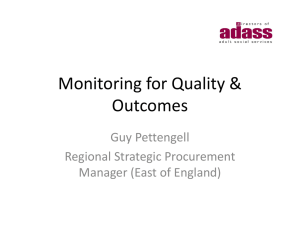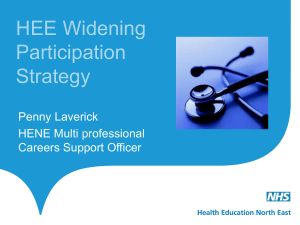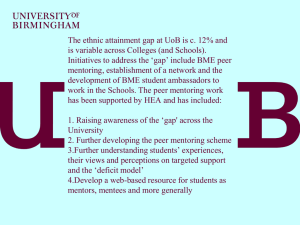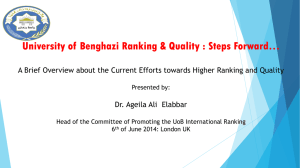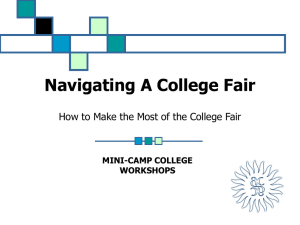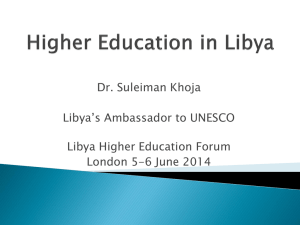Measuring the Measures
advertisement
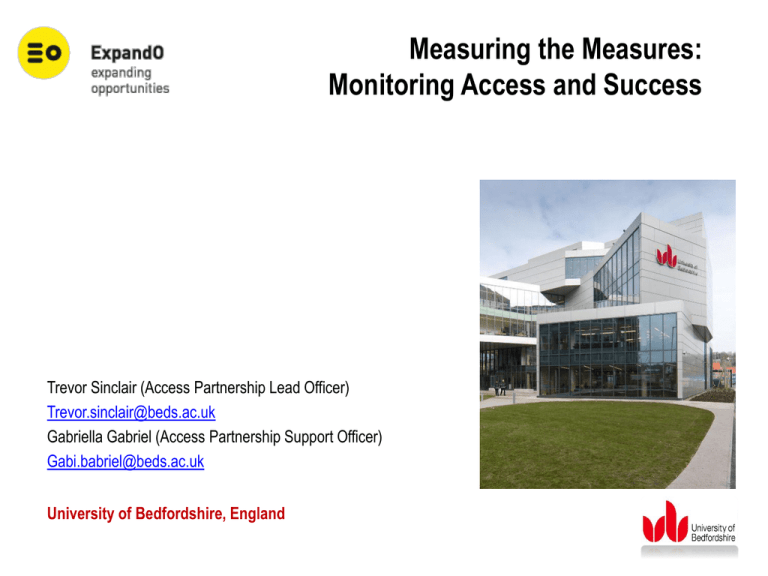
Measuring the Measures: Monitoring Access and Success Trevor Sinclair (Access Partnership Lead Officer) Trevor.sinclair@beds.ac.uk Gabriella Gabriel (Access Partnership Support Officer) Gabi.babriel@beds.ac.uk University of Bedfordshire, England Some context… Education system in England • Education compulsory from ages 5-16 • Participation age now being raised to 18 • Different school structures in different counties • Schools moving out of local authority control (academies, free schools, University Tech Colleges) • Post-compulsory education in schools, colleges and universities – vocational qualifications (incl. advanced / higher apprenticeships), Foundation Degrees, Bachelor’s Degrees and beyond to postgraduate, research degrees etc. The National Picture: Age Participation (England) The National Picture: Widening Participation (England) Indicator 2002-03 2003-04 2004-05 2005-06 2006-07 2007-08 Percentage of young entrants to full-time first degree courses from low-participation neighbourhoods n/a n/a n/a 9.2 9.6 9.9 Percentage of young entrants to full-time first degree courses from state schools 86.4 86.1 85.9 86.9 87.2 87.4 Percentage of young entrants to full-time first degree courses from NS-SEC groups 4 to 7 27.9 28.2 27.9 29.1 29.8 29.4 Percentage of full-time first degree students in receipt of Disabled Students' Allowance 2.6 3.1 3.7 4.1 4.4 4.6 Progression to Higher Education • • • • <1 in 5 from the most disadvantaged areas (WP) in England compared with 1 in 2 in the most advantaged areas 87% of private school students and 71% in state school sixth forms progress to HE Disadvantaged young people are up to 15 times less likely to attend the most selective universities (no significant change since mid-1990s) Dr. Anna Mountford-Zimdars, King’s College London The National Picture : Trends in Young Participation Source: HEFCE (2013), Trends in young participation in Higher Education Young Participation Rates: Trends by parliamentary constituency Change in Government • Introduction of tuition fee charges (in excess of £6,000 p.a.) HEIs required to submit ‘Access Agreements’ to the Office for Fair Access (OFFA) • Emphasis on HEIs to developing strategies to widen access and participation of nontraditional entrants • Closure of the national Aimhigher initiative (July 2011) Access Agreements and OFFA Core Aims: • • • Support and encourage the number and/or proportions of students in higher education from low income families and other under-represented groups Reduce barriers to higher education for students from these groups (invest in outreach and financial support) Support and encourage equality of opportunity through Information Advice & Guidance (IAG) on financial information to students, parents/carers and advisers http://www.offa.org.uk Data Collection for WP cohort • • • • In its response to OFFA the University of Bedfordshire (UoB) Access Agreement outlines a significant investment into the development of an Access Partnership Programme (focus on the delivery of outreach activities in WP schools/colleges NS-SEC 4-7, POLAR3) The Access Agreement sets out key targets for the UoB (see next slide) Data is collected using the Higher Education Access Tracker (HEAT) e.g. postcode, institution, participant’s name, gender, date of birth, ethnicity and disability. HEAT provides a progressive tracking system mapping the student life cycle from compulsory education to graduation and beyond (see APP diagram) Note: Ongoing issues exist around data sharing and data protection The local picture: our Access Agreement Note: There is also an ambition to improve the percentage of first-class and/or upper second-class degrees irrespective of background Sustained partnership approach across ages, stages, sectors and institutions “A partial experience…” Bill Rammell (Vice Chancellor - University of Bedfordshire) conveyed the message that students would be better off not participating in HE rather than having a partial experience, warning of the potential damage caused to students dropping out of their university education (HEA, 2012) What Works? (Thomas, 2012) Difficulties, Challenges and Solutions Difficulties • Full engagement and buy-in across the university (silo mentality) • Data systems can be fragmented and disconnected from one another • Cooperation from schools/colleges and the University in terms of data collection and sharing of data Challenges • Creating a coherent and unified approach to access across the University and HE sector as a whole • Getting WP students to take up opportunities e.g. EMUS Solutions • Vice-Chancellor’s commitment to widening access (investment and resource) • Creation of posts to develop access work across the University e.g. Graduate Access Fellows, Associates and Faculty Internships • Appointment of an Evaluation & Monitoring Officer (Access Partnership) • Membership - Forum of Access and Continuing Education / National Education Opportunities Network (pivotal in galvanizing widening access practitioner) Access Partnership Structure Access at the University of Bedfordshire • • • • • • • • Equality & Diversity Forum (Staff & Students) Access Forum (Mature Learners) Widening Participation Action Group Peer Assisted Learning Professional and Academic Development Looked After Children - LAC (Buttle UK Quality Mark) Black & Minority Ethnic - BME (National Mentoring Consortium) Increased work with disabled students Access and BME students: Ethnic Minority Undergraduate Scheme Research and experience show that compared with their peers, Black and Asian undergraduates are more likely to be highly qualified (NMC, 2013). However they; • are twice as likely to be unemployed • are half as likely to be offered employment in their final year • perform less well completing application forms and at interviews • have to make more applications before obtaining interviews The proportions of UG Home BME students at the UoB are as follows: • 47% - Of all UG Home Students • 40% - Of all (PG and UG) Home students • 32% - Of all (UG, PG and Home Overseas) students Note: Does not include students studying abroad and only include those registered for (2013/14). References Higher Education Academy (2012). ‘Setting this context within a wider context’, http://www.heacademy.ac.uk/events/detail/2012/seminars/themes/TW059_plymouth_uni National Mentoring Consortium (2013) http://www.uel.ac.uk/nmc/ Thomas, L. (2012) Building student engagement and belonging in higher education at a time of change: a summary of findings and recommendations from the What Works? Student Retention & Success programme. York: Higher Education Academy [Online]. Available at http://www.heacademy.ac.uk/assets/documents/what-works-studentretention/What_works_summary_report.pdf



